
Grilling the perfect ribeye steak hinges on hitting the right temperature. So, what temperature should ribeye be grilled at? This guide will walk you through the ideal temperature range for grilling ribeye steaks, helping you achieve juicy, tender results every time. You’ll discover how to nail that perfect cook, ensuring your ribeyes come off the grill flavorful and grilled to perfection every single time.
Key Takeaways
- The ideal grilling temperature for ribeye steaks is between 450°F and 500°F.
- Achieving the right internal temperature is crucial for juicy, tender ribeye.
- Proper seasoning and marinating can enhance the natural flavor of the ribeye.
- Grill setup and temperature management are essential for evenly cooked steaks.
- Letting the ribeye rest and slicing it against the grain will result in the most tender and flavorful bites.
Understanding Ribeye Steak
Before you fire up the grill for a ribeye steak, it’s important to understand what makes this cut so special. Ribeye is renowned for its abundant marbling — the delicate streaks of fat throughout the meat. This marbling not only adds richness and depth of flavor but also keeps the steak incredibly tender and juicy when cooked.
Cut and Marbling
Ribeye comes from the cow’s rib section, between the shoulder and the loin. This spot is very active, making the steak tender and tasty. The steak’s fat content, or marbling, keeps it moist and juicy when grilled.
Flavor Profile
Ribeye is one of the most flavorful beef cuts, prized for its rich fat content and unique muscle fibers. The marbled fat enhances the steak’s taste while keeping it exceptionally juicy and tender. When seasoned properly and cooked at the perfect ribeye grilling temperature, this cut transforms into a true delight for your taste buds.
| Characteristic | Description |
|---|---|
| Cut | Taken from the rib section of the cow, between the shoulder and the loin |
| Marbling | Abundant intramuscular fat, contributing to the steak’s tenderness and flavor |
| Flavor Profile | Rich, beefy, and well-balanced, with a tender and juicy texture |
“Ribeye is considered one of the most flavorful cuts of beef, thanks to its high-fat content and the unique muscle fibers found in the rib section.”
Preparing for the Grill
Getting ready is key to grilling the perfect ribeye. Start by seasoning the steak generously with salt, pepper, and your favorite spices or herbs. If you like, you can also marinate your ribeye steak to boost flavor and help keep it tender during cooking. Knowing the right ribeye grilling temperature will make sure your preparation shines through in every juicy bite.
Seasoning and Marinating
Seasoning your ribeye for the perfect grill temperature is simple yet crucial. Start by sprinkling salt and freshly cracked black pepper evenly over the steak. For an extra kick, experiment with different dry rubs or spice blends that complement the rich flavor of ribeye. To deepen the taste even more, try marinating your steak in a mixture of olive oil, vinegar or citrus juice, and fresh herbs — a tried-and-true method in any ribeye grilling guide.
- Seasoning ideas: salt, pepper, garlic powder, onion powder, dried herbs
- Marinade ingredients: olive oil, balsamic vinegar, soy sauce, Worcestershire sauce, minced garlic, fresh herbs
Don’t forget to let the steak warm up to room temperature before grilling. This makes it cook evenly and ensures a grilling ribeye steak tips juicy and tasty result.
Grill Setup and Temperature
To achieve the perfect grilled ribeye, start by preparing your grill with the right setup and temperature. Preheat your grill to a high heat zone, ideally between 450°F and 550°F (232°C to 288°C). This intense heat will create a beautiful sear on the outside while cooking the inside evenly to your preferred doneness.
Here are some tips for setting up your grill:
- Preheat your grill to a high heat, anywhere from 450°F to 550°F (232°C to 288°C).
- If using a gas grill, set the burners to high and let the grill heat up before adding the steak.
- For a charcoal grill, arrange the coals in a single layer and let them burn until they are hot enough, covered in a light gray ash.
- Clean the grill grates well to prevent the steak from sticking.
Getting your grill hot is key for the perfect ribeye steak grilling temperature and ribeye doneness temperature. This high heat creates a tasty sear and cooks the steak to your desired doneness, whether it’s juicy medium-rare or firm medium-well.
The secret to grilling an amazing what temperature should ribeye be grilled at is a blazing-hot grill. Keep an eye on the temperature as you cook. With the right perfect ribeye grill temp and skills, you’ll soon be a pro at grilling ribeye steak tips.
What Temperature Should Ribeye Be Grilled At?
Grilling the perfect ribeye steak starts with mastering the right temperature. Aim for a grill heat between 450°F and 550°F (232°C to 288°C). This high heat creates a flavorful sear on the outside while cooking the steak evenly to your preferred doneness — whether that’s rare, medium-rare, medium, or medium-well.
Here are some tips to get the ribeye steak grilling temperature spot on:
- Preheat your grill to the desired temperature range, letting it heat up fully before adding your steak.
- Try different perfect ribeye grill temp settings to see what works best for you and your steak’s thickness.
- Use a meat thermometer to check the ribeye doneness temperature while it cooks, aiming for your perfect doneness.
- Watch the steak closely and adjust the ribeye grill cooking time and temperature as needed for the best results.
With practice and a bit of experimentation, you’ll master the ribeye grilling guide. You’ll consistently produce juicy, flavorful grilling ribeye steak tips.
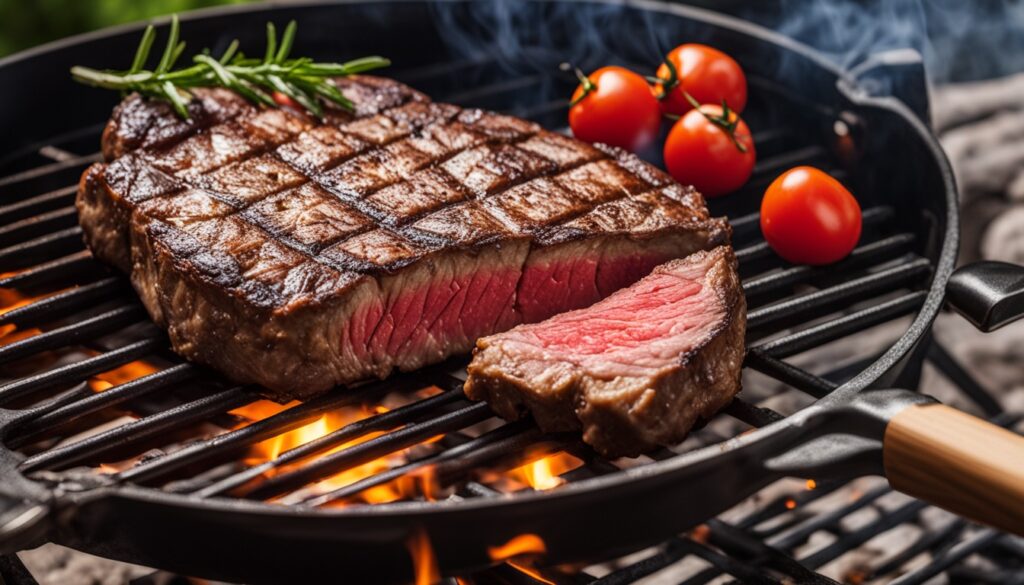
Determining Doneness
Getting the ribeye steak grilling temperature right is key. You need to use tools and techniques to check if your steak is cooked how you like it. Look at the internal temperature and use your eyes and hands to check too.
Using a Meat Thermometer
A meat thermometer is a must-have for grilling fans. Put the thermometer into the steak’s thickest part, away from bone or fat. For a rare ribeye, the internal temperature should be 125°F (52°C). For medium-rare, it’s 130-135°F (54-57°C), medium is 140-145°F (60-63°C), and medium-well is 150-155°F (66-68°C).
Visual and Touch Cues
A meat thermometer provides precise readings to help you nail the perfect ribeye doneness temperature. But you can also rely on visual cues and touch to gauge progress. As the steak cooks, its color changes from red to pink to gray. Feeling the steak’s firmness gives clues too — a rare steak feels soft and tender, while a well-done steak is noticeably firmer and more solid.
Using a meat thermometer and watching for color and feel helps you find the perfect ribeye grill temp. This way, you can make sure your steak is just right every time.
Resting and Slicing
After grilling your ribeye steak to the perfect ribeye doneness temperature, let it rest. This step lets the juices spread out evenly. It makes sure every bite is juicy and full of flavor.
Let your grilled ribeye rest for 5-10 minutes. This time, the steak’s internal temperature will keep rising. It will hit the ribeye steak grilling temperature you want. Resting the meat relaxes the muscles, keeping the juices inside when you slice.
When you’re ready to serve, slice the ribeye. Make sure to slice against the grain for tender bites. This way, each slice is tender and matches the rich ribeye grill cooking taste.
Resting your steak is just as important as knowing what temperature ribeye should be grilled at — it allows the juices to redistribute, ensuring every bite is consistently juicy and flavorful.
Resting and slicing your ribeye grilling guide right will make your steak amazing. Your guests will love it. Remember, patience is key with grilling ribeye steak tips. A little time spent well makes a big difference.
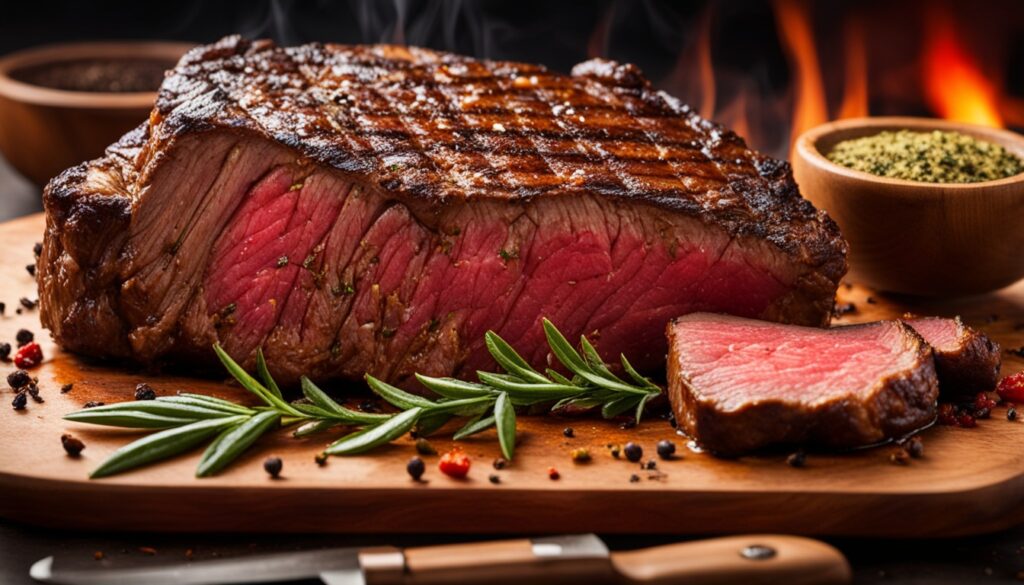
Serving Suggestions
Grilling the perfect ribeye steak is more than just the right temperature. After you’ve cooked it to perfection, think about how to serve it. Here are some ideas to make your meal even better.
Side Dishes and Sauces
Grilled ribeye steak goes well with many side dishes. Try roasted potatoes, grilled asparagus, or a fresh salad. These options balance the steak’s rich flavor and add texture.
For extra flavor, add a tasty sauce to your steak. Options like chimichurri, béarnaise, or red wine reduction can make the steak even better.
Remember, the perfect ribeye grill temp is just the start. Pair your steak with great side dishes and sauces for a memorable meal. This way, you’ll enjoy the best of what temperature should ribeye be grilled at and grilling ribeye steak tips.
“The secret to a great steak is not just the ribeye steak grilling temperature, but how you present and serve it.”
Conclusion
Grilling the perfect ribeye steak is truly an art that anyone can master with the right knowledge and techniques. By understanding the ideal grilling temperature, proper steak preparation, and reliable methods for determining ribeye doneness temperature, you’ll elevate your grilling skills to a new level. With practice, you’ll consistently produce mouthwatering ribeye steaks that impress every time.
Experiment, adjust based on your preferences, and enjoy the process of perfecting your ribeye grilling skills. This guide has given you the essential tips and techniques to master the art of grilling ribeye steak. Follow the steps in this ribeye grilling guide to become a grilling ribeye steak tips expert. Impress your friends and family with your culinary prowess.
So, fire up your grill, get ready to sear some juicy, flavorful ribeye steaks, and savor the fruits of your labor. Enjoy the process, and embrace the journey of continuously improving your what temperature should ribeye be grilled at skills. Happy grilling!
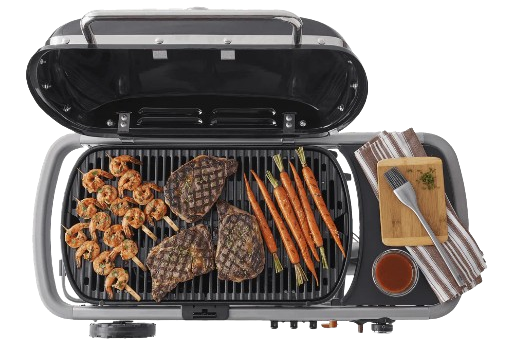
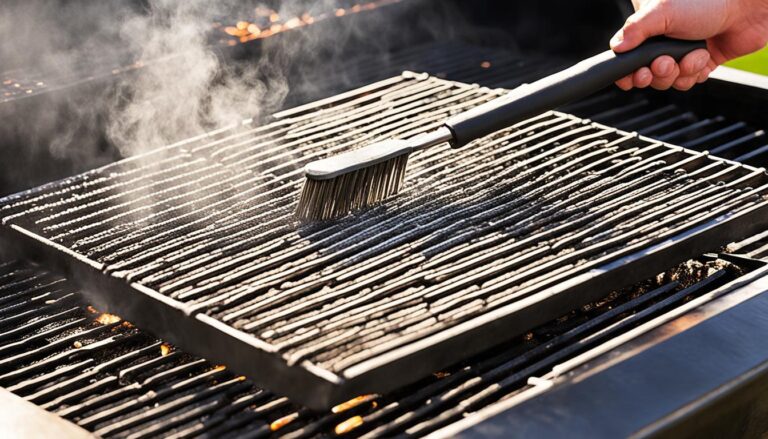
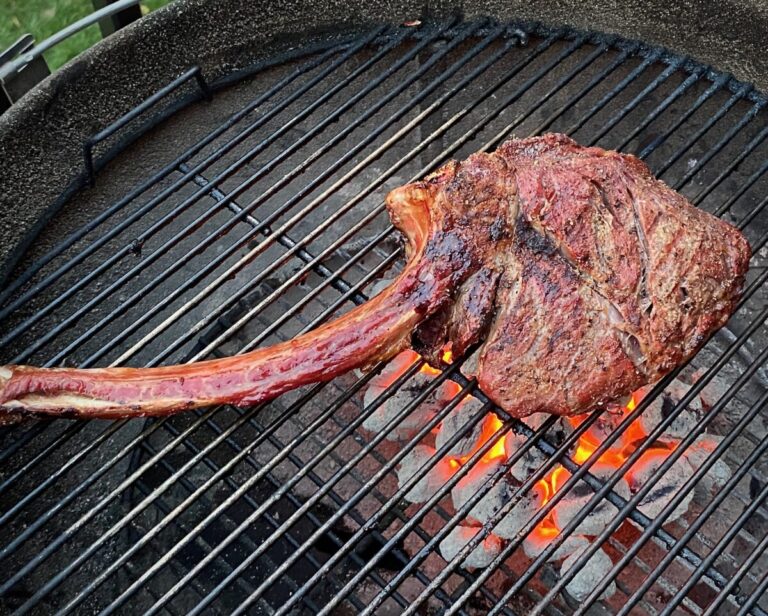
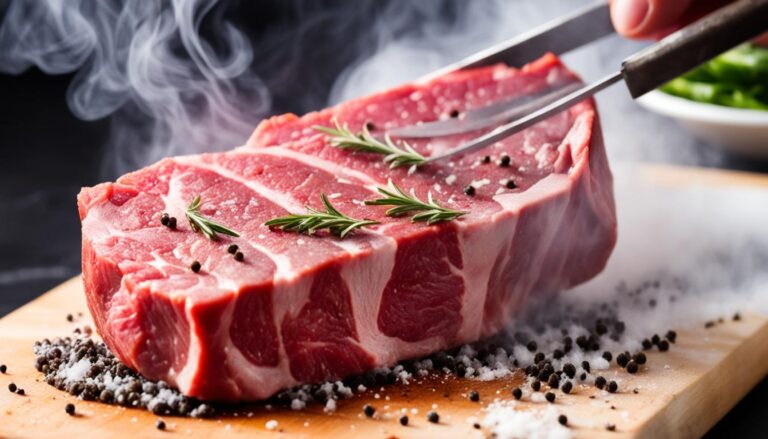
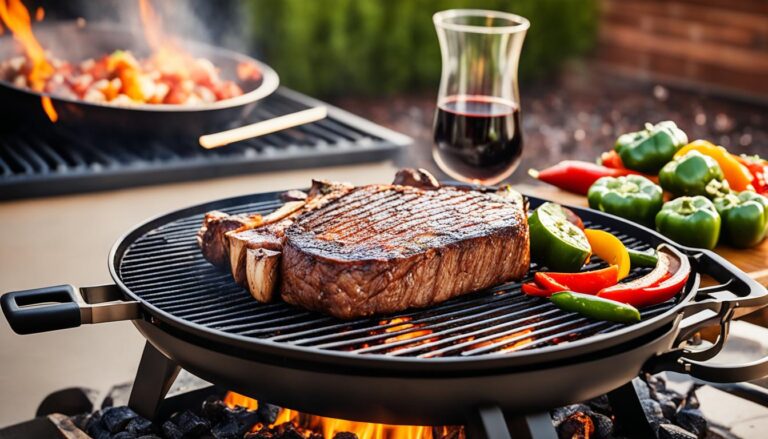
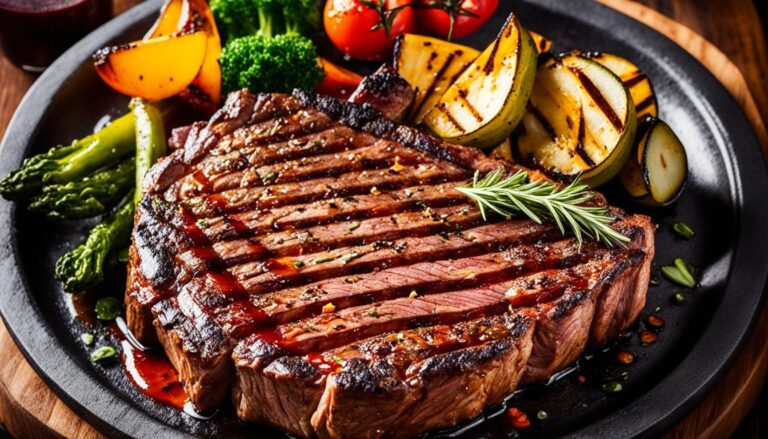
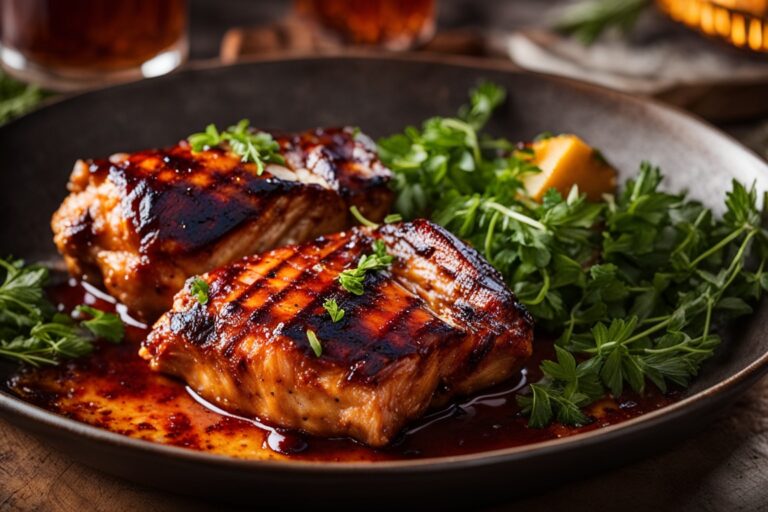
One Comment